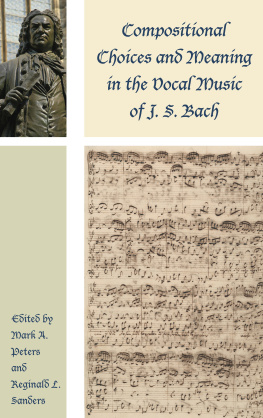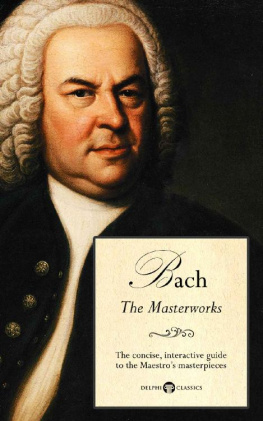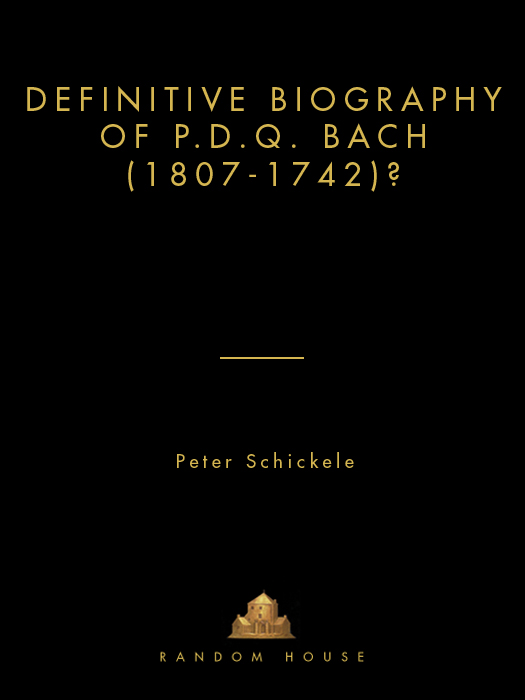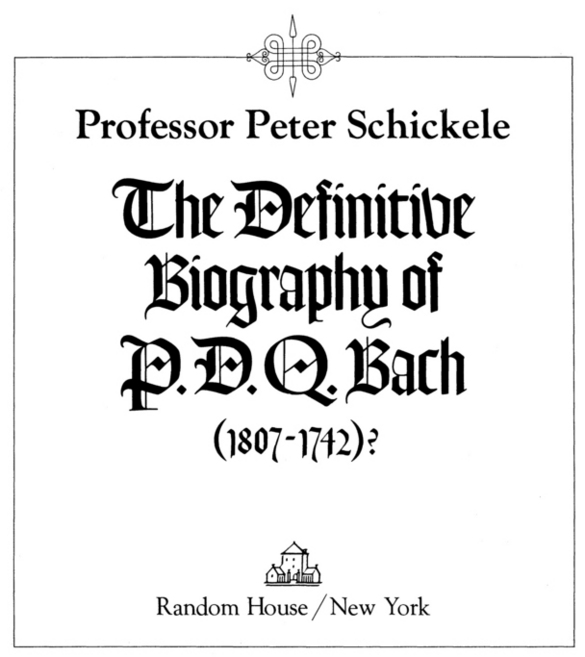
Copyright 1976 by Peter Schickele
All rights reserved under International and Pan-American Copyright Conventions.
Published in the United States by Random House, Inc., New York,
and simultaneously in Canada by Random House
of Canada Limited, Toronto.
Library of Congress Cataloging in Publication Data
Schickele, Peter.
The definitive biography of P. D. Q. Bach.
1. MusicAnecdotes, facetiae, satire, etc.
2. BiographyAnecdotes, facetiae, satire, etc.
I. Title.
ML65.S34 813.54 75-31682
eISBN: 978-0-307-76962-6
v3.1
Dedication
In Memory of
WOLFGANG AMADEUS MOZART
(17561791)
Why not?What?Why not?Why should I not send it?Why should I not dispatch it?Why not?Strange! I dont know why I shouldntWell, thenyou will do me this favor.Why not?Why should you not do it?Why not?Strange! I shall do the same for you, when you want me to. Why not? Why should I not do it for you? Strange! Why not?I cant think why not?
Letter to his cousin Maria
SPIKE JONES
(1911-1965)
Turn the page, ya fathead!
Glowworm
Preface
Why? That is the question most often asked, by musicians and laypersons alike, after the concerts of P. D. Q. Bachs music presented by the author across the width and breadth of the North American continent. In the sixteen years that have elapsed since he began regularly performing the works of this musical missing link, the author estimates that that question, WHY? has been asked more than two thousand times in his presence; the number of times it has been asked behind his back, were it ascertainable, would surely boggle the mind, and a boggled mind is of no use to anyone. For that reason alone it would seem that providing some answers to this extraordinarily persistent questionprobably the third most often-asked question in the Western hemisphere (after What is the meaning of life? and Who was that lady I saw you with last night?)should be an incidental but nevertheless Number One concern for anybody purporting to write a definitive account of what is known about the strangest stop (if one may be permitted a metaphor) on the Bach family organ.
One of the answers to the question is tied to the development of the long-playing record: the over-idolizing of historical figures is usually followed by a period of debunking, and during the last couple of decades, which have seen the recording of virtually everything written by J. S. Bach, there has naturally developed an interest in the soft underbelly of eighteenth-century music, the so-called Seamy Side of the Baroque. This is perfectly normal and nothing to be worried about.
For another answer to the question we may adopt the reasoning of a United States senator from the midwest, who, when one of then-President Nixons nominees to the Supreme Court was criticized as being mediocre, came to the nominees defense by pointing out that many people in this country are mediocre, and why shouldnt they be represented on the Supreme Court? The author has actually found that P. D. Q. Bachs music is capable of having a therapeutic effect on audiences; the works of J. S. Bach and Mozart are so serenely perfect that many people come away from hearing them with an aggravated inferiority complex caused by the knowledge that no matter how hard they try they can never hope to achieve such beauty, whereas hearing the works of P. D. Q. Bach comforts the listener with the ego-building and not unrealistic feeling that, even if he has had no music lessons, he could easily do as well with one ear, as it were, tied behind his back.
Finally, the author has been the victim of many attacks, ranging from the petty to the downright dangerous, by various vested interests as well as parties in two-piece suits; the nature of some of these assaults is touched upon in the pages that follow, but one of the charges, the vilest, most scurrilously scandalous of them all, must be mentioned here: the insinuation, sometimes made subtly and sometimes blatantly, that P. D. Q. Bach is a figmental entity, a being no less the creation of this author than was Tarzan of Edgar Rice Burroughs or Howard Hughes of Clifford Irving. It should be unnecessary for a tenured university professor to defend himself against such a patently false accusation, such an absurd calumny, such a big fat lie, but under the circumstances he must welcome the opportunity provided in these pages to present the evidence and, it is hoped, silence forever the seemingly numberless Doubting Thomases, Richards, and Harolds who (to our eternal shame) fill most of our musical chairs.
P.S.
University of Southern North Dakota at Hoople 23 July 1975
11:47 p.m.
Preface to the English Language Edition
It may seem, on first thought, somewhat redundant to include a Preface to the English Language Edition in a book that was written in the English language in the first place and has not even been translated into any other languages anyway. But if the reader will bear with him for a moment the author would like to point out that if P. D. Q. Bach had not been effectively elbowed out of the bus of history for nearly two centuries, scholarly inquiry into his life and work would have begun in its proper place, that is to say, Germany and Austria, and there would by now have been, if not an entire book, at least several articles in the various German-language musicological journals. With this in mind, and in order partly to make up for this lack, the author has tried to preserve the lengthy sentences and fastidious punctuation that would have characterized those articles had they been written.
P.S.
University of Southern North Dakota at Hoople 24 July 1975
12:03 a.m.
Foreword
Know thyself, said Romeo to Portia, and he might have added, Know thy audience. Perhaps the most important decision the author of a scholarly work must make is: For whom is this book written? Is it written for the authors fellow scholars, for (in this case) musicians in general, or for that broad, undifferentiated mass known as the lay public?
The experience of the past decade and a half has shown that interestwhether it takes the form of attraction or repulsionin P. D. Q. Bach can be found in all three of the above-mentioned categories. For this reason the author of the present work has attempted to meld several different stylistic approaches into one verbal salad, so to speak, combining the exhaustive attention to detail found in scholarly writing with the anecdotal appeal of the more popular biography. Many of P. D. Q. Bachs most ardent admirers are not yet able to read, and they will be pleased to discover that the book is profusely illustrated, whereas the trained musician will find food for thought in the technical analysis of a P. D. Q. Bach piece which constitutes one of the appendices.
It is to be hoped that when this humble literary effort takes its final bow in the eyes of its beholders it will be found to have had, as the saying goes, something for everyone and everyone for something.
Introduction
The most controversial aspect of P. D. Q. Bachs life, aside from its existence, is the time of its existence, that is, his dates. It has become traditional to list his dates as they were inscribed on his first tomb: 18071742; this has led to a great deal of confusion and a seemingly endless flow of possible explanations.













